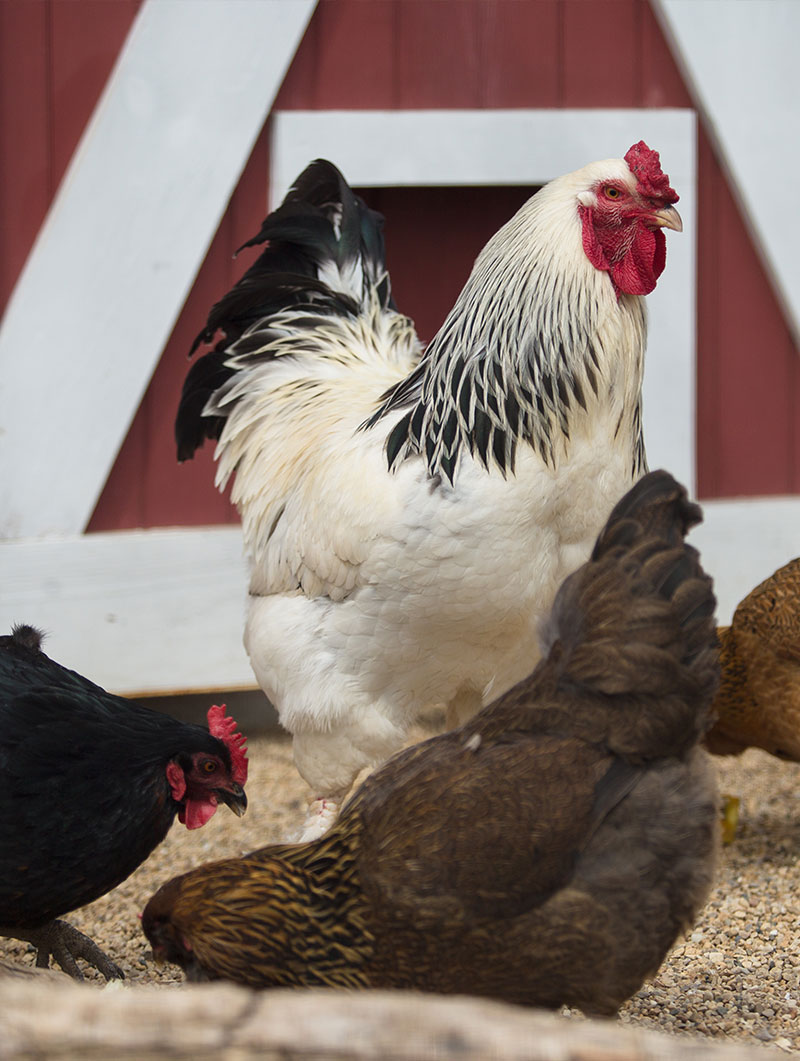Chickens
Gallus domesticus
Description:
Chickens come in many different breeds and a variety of colors. Almost all breeds of chickens have a featherless comb on their heads and wattles under their chins. Females (hens) typically have shorter tails and smaller combs and wattles than the males (roosters). Chickens have four toes on their feet, three pointing forwards and one pointing backwards.
Size:
Chickens can range in weight from ½ pound up to 13 pounds (0.2-5.9 kg), with most chickens weighing in the 7-10 pound (3.2-4.5 kg) range.
Adaptations:
- The bones of many birds are hollow to make the bird lighter and more efficient at flight. Although chickens’ bodies are generally too heavy to fly very far, they do still have the hollow bones common to all birds.
- Chickens have flexible toes with claws that allow them to dig for food and defend themselves.
- Roosters have pointed spurs on the back of their legs that they use for defense.
- Chickens do not have teeth, but they are able to break down their food in an organ called the gizzard. The gizzard is a part of the stomach that uses small rocks swallowed by the bird to help grind food into smaller pieces.
Diet:
The chickens at Cosley Zoo are fed a commercial chicken diet, fruits and vegetables.
Reproduction:
When a hen ovulates, the yolk of an egg is produced. This yolk then travels into the hen’s oviduct, where it may be fertilized by sperm from a rooster. As the egg travels farther through the oviduct, it is covered by a membrane and a substance called albumin (egg white). As the egg reaches the bottom of the oviduct, a shell is deposited around it and the egg is laid. It takes about one day for the egg to complete this process. A fertile egg with proper incubation takes about 21 days to develop into a chick. A hen can lay an egg even if she has not mated with a rooster; therefore, not all eggs are fertile.
Shelter and space needs:
Farm-raised chickens are given a variety of types of housing, from the conventional chicken coop to free range. Basic chicken needs include access to food and water, a shelter from weather and predators, room to exercise, and places to roost and nest. Cosley Zoo’s chickens have an outside yard as well as an indoor coop, which contains their nest boxes, roosts for sleeping, food and water.
Life expectancy:
The average life expectancy of a chicken raised as a pet is about 8 years.
Relationship with man:
Domestic chickens provide people with meat, eggs, and feathers.
Fun Facts:
- Chicken eggs come in a variety of colors. The color of an egg reflects the skin color of the hen that laid it. Cosley Zoo’s chickens lay eggs that are white, brown, and even green!
- There are more chickens than humans in the world.
- Eggshells have as many as 17,000 pores on their surfaces to provide air to the developing chicks.
- Chickens lay more eggs in the summer when there are longer periods of daylight. To keep their hens productive, many poultry farmers use supplemental lighting in their coops in winter.






